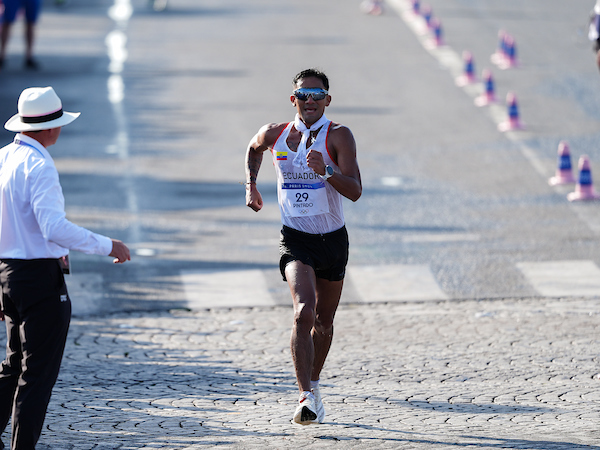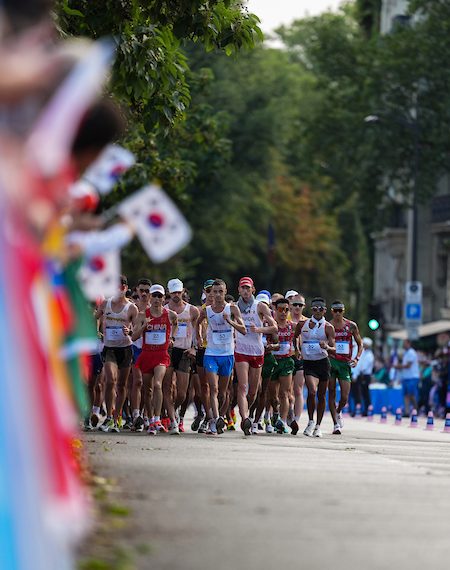This is Elliott Denman, our most senior writer, who has written for us since 1990, and at the age of 90, the 1956 Olympic race walker knows his stuff. Elliott Denman has written for us since 1990; his fire, his excitement and his sense of history, and his voice makes him one of our most popular writers.
PARIS OLYMPIC RACEWALKERS
DRAW BIG CROWDS TO THE TROCADERO AREA;
THEIR SENIORITY DESERVES MORE RESPECT.
By ELLIOTT DENMAN
Fact: Men’s racewalking has been in the Olympic Games since 1904.
That means it’s been on the Games track and field program, in one form or another, longer than the javelin throw (which joined the card in 1906), and the 5,000 and 10,000 meters, decathlon and both 4×100 and 4×400 relays (which all commenced in 1912).
And, of course/of course, long before every women’s event.
You’d think that form of seniority would have accumulated.
Heaps of respect all these years, wouldn’t you?
You’d think the rest of the Olympic sport would have learned to appreciate its elders.
You’d think that the great champions of racewalking all those years would occupy pedestals as high as their immortal running-jumping-throwing colleagues.
You’d think that, in this day and age of Olympic “urban” inclusion, walking would be embraced as the most “urban” activity of them all. Heck, there are ‘interval training devices’ in every big city’s downtown—you know, those signs that say “walk now” and “don’t walk.”
Well, keep on pondering.
The first two racewalking events of the Games of the XXXIII Olympiad are already in the books. The men’s 20K and the women’s 20K was staged on the first day of August over an L-shaped one-kilometer loop course in the Trocadero area of Paris, in the shadow of the Eiffel Tower.
They were huge successes, great shows, attracting thickly-packed crowds, on the sidelines, generating excellent TV coverage and good racing news
That was quickly dispatched to some of the far corners of the planet.
But too many allegedly close followers of this sport—the one called athletics in virtually every nation but ours—chose to ignore it.
The first of August? That’s a great day for them to do sightseeing in another arrondissement. Paris has so many sights to see or catch up on their laundry.
To these folks, the Olympic track and field slate began on the second of August.
What a show they skipped.
Listen to two-time (1992-96) USA Olympic racewalker Allen James:
“Day one represented the most globally competitive event in the Olympic program….and that’s not just track and field.
“Look at the men’s 20 km. Walk.
“All six areas (of World Athletics’ geo-categories) were there. They are represented in the top 11 finishers.
“The separation between 9th to 11th was less than 1 second.
“The race had constant lead changes and negative splits throughout the race.
“Ecuador’s Brian Daniel Pintado beautifully negotiated it.
(1:18:55) with Brazil’s Caio Bonfim second (1:19:09.). That meant a great day for South America.

“Then came Europe, 3,4 and 9 – Spain’s Alvaro Martin, Italy’s Massimo Stano, and Aurelien Quinon of France, the home team.
“A North American was fifth (Canada’s Evan Dunfee)
“An African walker was sixth (Misgana Wakuyama of Ethiopia.)
“Then Asia 7-8-10 ( Japan’s Koki Ikeda and Yuta Koga; China’s Jun Zhang)
“Then Oceania 11th ( Declan Tingay, Australia).”
The women’s 20K immediately followed the men’s race—and, get this, it was even more global.
Said James: “We had five areas in the top five.”
It was Asia (China’s Jaiyu Yang 1:25:54), Europe (Spain’s Maria Perez 1:26:19), and Oceania (Australia’s Jemima Montag 1:26:25) on the podium, with South America (Lorena Arenas of Colombia) and North America ( Alekna Gonzalez of Mexico ) fourth and fifth.
“When does that happen other than the walks?” asked James.
His answer, of course, was “never.”

As James saw it, “Yang was phenomenal. She broke the field very early, and she set off on her own. The chase pack did everything they could to pull her back, but Yang was technically flawless and perfectly executed her solo journey.
“Perez and Montag made it much closer at the end, but it was all Yang.
“If anyone can find another event in any Olympic sport that comes close to this sort of high-quality representation from across the globe, please take up my challenge. “
They’d fall short by eons, by kilometers, by any measure.
Other observers chimed in (electronically.)
Sandi Lake: “Racewalking is hard.”
Jim McFadden: “We saw some great racing under tough conditions.”
Milton Brents Witty: “Awesome sport.”
Monica Zaragoza: “I need to learn how to do this.”
And this one aimed at racewalking’s critics:
Saul Richardson: “Yet people see nothing peculiar about swimming breaststroke or even swimming backward.”
Bottom lines: These global ambassadors of the racewalking game are
The truest of athletes.
Their event is underappreciated, but they would never want to detract from any other specialty.
They don’t like being kicked around by some of the folks in their
Sport’s hierarchy.
Are you listening, you moguls of the media?
Are we getting through to you, Lord Coe?
Et al.
Author

One of the finest and most prolific writers in our sport, Elliott Denman has written about our sport since 1956, when he represented the US in 1956 Olympic Games at the 50k race walk, the longest event on the Olympic schedule. A close observer of the sport, Elliott writes about all of our sport, combining the skills of a well honed writer with the style of ee Cummings. We are quite fortunate to have Elliott Denman as a friend and advisor.
View all posts





















Well written article. Racewalking is fun.
Thanks Ed! appreciate your comments! It means alot!
Thanks Ed, the racewalking events have a long tradition in the Olympics and World Champs.
Thanks Edward! I do enjoy and respect Race walking. Lots of tradition.